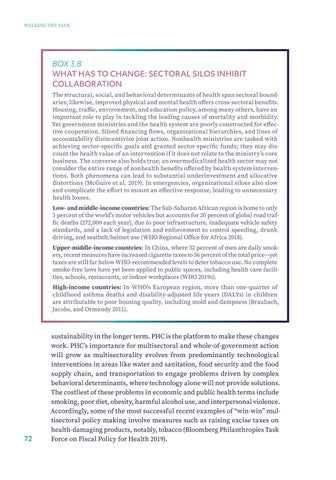WALKING THE TALK
BOX 3.8 WHAT HAS TO CHANGE: SECTORAL SILOS INHIBIT COLLABORATION The structural, social, and behavioral determinants of health span sectoral boundaries; likewise, improved physical and mental health offers cross-sectoral benefits. Housing, traffic, environment, and education policy, among many others, have an important role to play in tackling the leading causes of mortality and morbidity. Yet government ministries and the health system are poorly constructed for effective cooperation. Siloed financing flows, organizational hierarchies, and lines of accountability disincentivize joint action. Nonhealth ministries are tasked with achieving sector-specific goals and granted sector-specific funds; they may discount the health value of an intervention if it does not relate to the ministry’s core business. The converse also holds true; an overmedicalized health sector may not consider the entire range of nonhealth benefits offered by health system interventions. Both phenomena can lead to substantial underinvestment and allocative distortions (McGuire et al. 2019). In emergencies, organizational siloes also slow and complicate the effort to mount an effective response, leading to unnecessary health losses. Low- and middle-income countries: The Sub-Saharan African region is home to only 3 percent of the world’s motor vehicles but accounts for 20 percent of global road traffic deaths (272,000 each year), due to poor infrastructure, inadequate vehicle safety standards, and a lack of legislation and enforcement to control speeding, drunk driving, and seatbelt/helmet use (WHO Regional Office for Africa 2018). Upper-middle-income countries: In China, where 52 percent of men are daily smokers, recent measures have increased cigarette taxes to 56 percent of the total price—yet taxes are still far below WHO-recommended levels to deter tobacco use. No complete smoke-free laws have yet been applied to public spaces, including health care facilities, schools, restaurants, or indoor workplaces (WHO 2019c). High-income countries: In WHO’s European region, more than one-quarter of c hildhood asthma deaths and disability-adjusted life years (DALYs) in children are attributable to poor housing quality, including mold and dampness (Braubach, Jacobs, and Ormandy 2011).
72
sustainability in the longer term. PHC is the platform to make these changes work. PHC’s importance for multisectoral and whole-of-government action will grow as multisectorality evolves from predominantly technological interventions in areas like water and sanitation, food security and the food supply chain, and transportation to engage problems driven by complex behavioral determinants, where technology alone will not provide solutions. The costliest of these problems in economic and public health terms include smoking, poor diet, obesity, harmful alcohol use, and interpersonal violence. Accordingly, some of the most successful recent examples of “win-win” multisectoral policy making involve measures such as raising excise taxes on health-damaging products, notably, tobacco (Bloomberg Philanthropies Task Force on Fiscal Policy for Health 2019).


